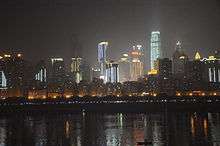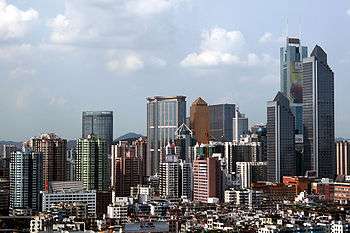Tianjin
Tianjin, formerly romanized as Tientsin, is a metropolis in northern coastal Mainland China, administered by the People's Republic of China and one of the five national central cities of China, with a total municipal population of 15,469,500.[2] It is governed as one of the four direct-controlled municipalities of the PRC and is thus under direct administration of the central government. Tianjin borders Hebei Province and Beijing Municipality, bounded to the east by the Bohai Gulf portion of the Yellow Sea. Part of the Bohai Economic Rim, it is the largest coastal city in northern China.
In terms of urban population, Tianjin is the fourth largest in China, after Shanghai, Beijing, and Guangzhou. In terms of administrative area population, Tianjin ranks fifth in Mainland China.[3] The walled city of Tianjin was built in 1404. As a treaty port since 1860, Tianjin has been a major seaport and gateway to the nation's capital. During the Boxer Rebellion the city was the seat of the Tianjin Provisional Government. In the period of late Qing dynasty and the Republic of China, Tianjin became one of the largest cities in China.[4] At that time, numerous western-style buildings and mansions were constructed in concessions, many of which are well-preserved today. After the founding of the People's Republic of China, Tianjin suffered a depression due to the policy of the central government and Tangshan earthquake, but recovered from 1990s.[5] Nowadays Tianjin is a dual-core city, with its main urban area (including the old city) located along the Hai River, which connects to the Yellow and Yangtze Rivers via the Grand Canal; and Binhai, a New Area urban core located east of the old city, on the coast of Bohai Sea. As of the end of 2010, around 285 Fortune 500 companies have set up base in Binhai, which is a new growth pole in China and is a hub of advanced industry and financial activity.
Name
Tianjin is the pinyin romanization of the Chinese characters 天津, which mean "Heavenly Ford" or "Ford of Heaven".
The origin of the name is obscure. One folk etymology is that it was an homage to the patriotic Chu poet Qu Yuan, whose "Li Sao" includes the verse "...departing from the Ford of Heaven at dawn..." (朝发轫于天津兮, zhāo fārèn yú Tiānjīn xī). Another is that it honors a former name of the Girl, a Chinese constellation recorded under the name Tianjin in the Astronomical Record section of the Book of Sui. A third is that it derives from a placename noted in the River Record of the History of Jin. The most common is that it was bestowed by the Yongle Emperor of the Ming, who crossed Tianjin's Gu River on his way south to overthrow his nephew the Jianwen Emperor.
History
The land where Tianjin is located today was created in ancient times by sedimentation of various rivers entering the sea at Bohai Gulf, including the Yellow River which entered the sea in this area at one point. Before this time, it was open sea.
The opening of the Grand Canal during the Sui dynasty prompted the development of Tianjin into a trading center.
Qing dynasty
During the Qing dynasty (1644–1911) Tianjin was promoted to a prefecture or Zhou (州) in 1725 with Tianjin County established under the prefecture in 1731. Later it was to upgraded to an urban prefecture or Fu (府) before becoming a relay station (驻地) under the command of the Viceroy of Zhili.
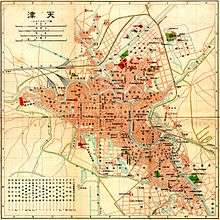
Opening up as a treaty port
In 1856, Chinese soldiers boarded The Arrow, a Chinese-owned ship registered in Hong Kong flying the British flag and suspected of piracy, smuggling, and of being engaged in the opium trade. They captured 12 men and imprisoned them. In response, the British and French sent gunboats under the command of Admiral Sir Michael Seymour to capture the Taku forts near Tianjin in May 1858. At the end of the first part of the Second Opium War in June of the same year, the British and French prevailed, and the Treaties of Tianjin were signed, which opened Tianjin to foreign trade. The treaties were ratified by the Emperor of China in 1860, and Tianjin was formally opened to Great Britain and France, and thus to the outside world. Between 1895 and 1900, Britain and France were joined by Japan, Germany and Russia, and even by countries without Chinese concessions such as Austria-Hungary, Italy and Belgium, in establishing self-contained concessions in Tianjin, each with its own prisons, schools, barracks and hospitals.[6] These nations left many architectural reminders of their rule, notably churches and thousands of villas. Today those villas provide an exotic flavour to Tianjin.

The presence of foreign influence in Tianjin was not always peaceful; one of the most serious violent incidents to take place was the Tianjin Church Incident. In June 1870, the orphanage held by the Wanghailou Church (Church Our Lady's Victories), in Tianjin, built by French Roman Catholic missionaries, was accused of the kidnapping and brainwashing of Chinese children. On June 21, the magistrate of Tianjin County initiated a showdown at the church that developed into violent clashes between the church's Christian supporters and non-Christian Tianjin residents. The furious protestors eventually burned down Wanghailou Church and the nearby French consulate and killed eighteen foreigners including ten French nuns, the French consul, and merchants. France and six other Western nations complained to the Qing government, which was forced to pay compensation for the incident.
In 1885 Li Hongzhang founded the Tianjin Military Academy 天津武備學堂 for Chinese army officers, with German advisers, as part of his military reforms.[7] The move was supported by Anhui Army commander Zhou Shengchuan.[7]:267 The academy was to serve Anhui Army and Green Standard Army officers. Various practical military, mathematic and science subjects were taught at the academy. The instructors were German officers.[7]:267 Another program was started at the academy for five years in 1887 to train teenagers as new army officers.[7]:268 Mathematics, practical and technical subjects, sciences, foreign languages, Chinese Classics and history were taught at the school. Exams were administered to students. The instruction for Tianjin Military Academy was copied at the Weihaiwei and Shanhaiguan military schools.[7]:268 The 'maritime defense fund' supplied the budget for the Tianjin Military Academy, which was shared with the Tianjin Naval Academy.[7]:268 The Tianjin Military Academy in 1886 adopted as part of its curriculum the Romance of the Three Kingdoms.[8] Among its alumni were Wang Yingkai and 段祺瑞 Duan Qirui. Among its staff was Yinchang.
In June 1900, the Boxers were able to seize control of much of Tianjin. On June 26, European defense forces heading towards Beijing were stopped by Boxers at nearby Langfang, and were defeated and forced to turn back to Tianjin. The foreign concessions were also under siege for several weeks.
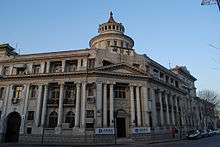
In July 1900, the Eight-Nation Alliance recaptured Tianjin. This alliance soon established the Tianjin Provisional Government, composed of representatives from each of the occupying forces (Russian, British, Japanese, German, French, American, Austro-Hungarian, and Italian). The city was governed by this council until August 15, 1902 when the city was returned to Qing control. Eminent Qing General Yuan Shikai led efforts to transform Tianjin into a modern city, establishing the first modern Chinese police force. In 1907, Yuan supervised China's first modern democratic elections for a county council.
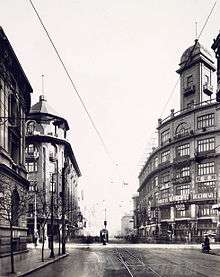
Western nations were permitted to garrison the area to ensure open access to Beijing. The British maintained a brigade of two battalions in Tianjin, and the Italians, French, Japanese, Germans, Russians, and Austro-Hungarians maintained understrength regiments; the United States did not initially participate. During World War I, the German and Austro-Hungarian garrisons were captured and held as Prisoners of War by Allied Forces while the Bolshevik government withdrew the Russian garrison in 1918. In 1920, the remaining participating nations asked the United States to join them, and the US then sent the 15th Infantry Regiment, less one battalion, to Tianjin from the Philippines.
Because of the rapid development of industry, commerce and finance, Tientsin was established as a municipality of China in 1927. From 1930 to 1935, Tientsin was the provincial capital of Hopeh, after that re-established as a municipality.
Garrison duty was highly regarded by the troops. General George C. Marshall, the "architect of victory" in World War II when he was the United States Army Chief of Staff, served at Tianjin in the 1920s as Executive Officer of the 15th Infantry. The US withdrew this unit in 1938 and a US presence was maintained only by the dispatch of a small US Marine Corps unit from the Embassy Guard at Beijing.

Second Sino-Japanese War
On July 30, 1937, Tianjin fell to Japan, as part of the Second Sino-Japanese War, but was not entirely occupied, as the Japanese for the most part respected foreign concessions until 1941, when the American and British concessions were occupied. In the summer of 1939, there occurred a major crisis in Anglo-Japanese relations with the Tientsin Incident. On June 14, 1939, the Imperial Japanese Army surrounded and blockaded the British concession over the refusal of the British authorities to hand over to the Japanese six Chinese who had assassinated a locally prominent Japanese collaborator, and had taken refuge in the British concession. For a time, the 1939 crisis appeared likely to cause an Anglo-Japanese war, especially when reports of the maltreatment by the Japanese Army of British subjects wishing to leave or enter the concession appeared in the British press. The crisis ended when the British Prime Minister Neville Chamberlain was advised by the Royal Navy and the Foreign Office that the only way to force the Japanese to lift the blockade was to send the main British battle fleet to Far Eastern waters, and that given the current crisis in Europe that it would be inappropriate to send the British fleet out of European waters, thus leading the British to finally turn over the six Chinese, who were then executed by the Japanese. During the Japanese occupation, Tianjin was ruled by the North China Executive Committee, a puppet state based in Beijing.
On August 9, 1940, all of the British troops in Tianjin were ordered to withdraw. On November 14, 1941 the American Marine unit stationed in Tianjin was ordered to leave, but before this could be accomplished, the Japanese attacked the United States. The American Marine detachment surrendered to the Japanese on December 8, 1941. Only the Italian and French concessions (the local French officials were loyal to Vichy) were allowed by the Japanese to remain. When Italy signed an armistice with the Allies in September 1943, Japanese troops took the Italian concession following a battle with its garrison, and the Italian Social Republic formally ceded it to Wang Jingwei's Japan-controlled puppet state. Japanese occupation of the city lasted until August 15, 1945, with the surrender of Japan marking the end of World War II.
Post World War II
In Pingjin Campaign of Chinese Civil War, the city was captured after 29 hours of fighting. Finally the Communists took over Tianjin on 15 January 1949.
More recently, since 2008 Tianjin has held the Annual Meeting of the New Champions of World Economic Forum (also called Summer Davos), in alternating years with another Chinese city, Dalian.[9]
In October 2010, the UN Climate Change Conference convened in Tianjin.[10]

On 12 August 2015, huge explosions in the Binhai area of the city caused widespread damage and hundreds of casualties.[11] Chinese state media reported that at least the initial blast was from unknown hazardous materials in shipping containers at a plant warehouse owned by Ruihai Logistics,[12] a firm specializing in handling hazardous materials.[13] 173 people were killed, nearly 800 others were wounded, and eight remain missing.[14][15]
Geography
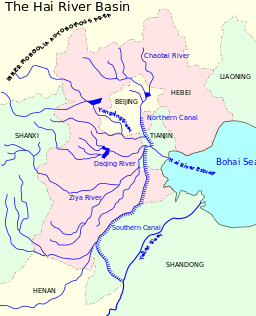
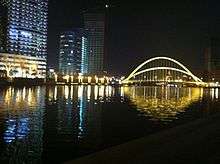
Tianjin is located along the west coast of the Bohai Gulf, looking out to the provinces Shandong and Liaoning across those waters, bordered by Beijing 120 kilometres (75 mi) to the northwest, and except for the east, is surrounded on all sides by Hebei. With a latitude ranging from 38° 34' to 40° 15' N, and longitude ranging from 116° 43' to 118° 04' E, the total area is 11,860.63 square kilometres (4,579.41 square miles). There is 153 km (95 mi) of coastline and 1,137.48 kilometres (706.80 miles) of land border.[16] It lies at the northern end of the Grand Canal of China, which connects with the Yellow River and Yangtze River. The municipality is generally flat, and swampy near the coast, but hilly in the far north, where the Yan Mountains intrude into northern Tianjin. The highest point in the municipality is Jiuding Peak (九顶山) in Ji County on the northern border with Hebei, at an altitude of 1,078.5 m (3,538 ft).
The Hai River forms within Tianjin Municipality at the confluence of the Ziya River (子牙河), Daqing River (大清河), Yongding River, North Grand Canal, and South Grand Canal, and enters the Pacific Ocean within the municipality as well, in Tanggu District. Major reservoirs include the Beidagang Reservoir in the extreme south (in Dagang District) and the Yuqiao Reservoir in the extreme north in Ji County.
Climate
Tianjin features a four-season, monsoon-influenced climate, typical of East Asia, with cold, windy, very dry winters reflecting the influence of the vast Siberian anticyclone, and hot, humid summers, due to the monsoon. Spring in the city is dry and windy, occasionally seeing sandstorms blowing in from the Gobi Desert, capable of lasting for several days. The monthly 24-hour average temperature ranges from −3.4 °C (25.9 °F) in January to 26.8 °C (80.2 °F) in July, with an annual mean of 12.90 °C (55.2 °F). With monthly percent possible sunshine ranging from 48% in July to 61% in October, the city receives 2,522 hours of bright sunshine annually. Having a low annual total precipitation of 511 millimetres (20.1 in), and nearly three-fifths of it occurring in July and August alone, the city lies within the semi-arid zone, with parts of the municipality being humid continental (Köppen Dwa/BSk, respectively).[17]
Extreme temperatures have ranged from −22.9 °C (−9 °F) to 40.5 °C (105 °F).[18]
| Climate data for Tianjin (1981–2010) | |||||||||||||
|---|---|---|---|---|---|---|---|---|---|---|---|---|---|
| Month | Jan | Feb | Mar | Apr | May | Jun | Jul | Aug | Sep | Oct | Nov | Dec | Year |
| Record high °C (°F) | 14.3 (57.7) |
20.8 (69.4) |
30.5 (86.9) |
33.1 (91.6) |
40.5 (104.9) |
39.6 (103.3) |
40.5 (104.9) |
37.4 (99.3) |
34.9 (94.8) |
30.8 (87.4) |
23.1 (73.6) |
14.4 (57.9) |
40.5 (104.9) |
| Average high °C (°F) | 2.0 (35.6) |
5.7 (42.3) |
12.2 (54) |
20.9 (69.6) |
26.5 (79.7) |
30.2 (86.4) |
31.3 (88.3) |
30.5 (86.9) |
26.6 (79.9) |
19.9 (67.8) |
10.6 (51.1) |
3.8 (38.8) |
18.4 (65.1) |
| Daily mean °C (°F) | −3.4 (25.9) |
−0.1 (31.8) |
6.4 (43.5) |
14.7 (58.5) |
20.5 (68.9) |
24.8 (76.6) |
26.8 (80.2) |
25.9 (78.6) |
21.1 (70) |
14.1 (57.4) |
5.2 (41.4) |
−1.2 (29.8) |
12.9 (55.22) |
| Average low °C (°F) | −7.4 (18.7) |
−4.4 (24.1) |
1.7 (35.1) |
9.3 (48.7) |
15.1 (59.2) |
20.0 (68) |
22.9 (73.2) |
22.2 (72) |
16.7 (62.1) |
9.4 (48.9) |
1.1 (34) |
−5 (23) |
8.5 (47.3) |
| Record low °C (°F) | −18.1 (−0.6) |
−22.9 (−9.2) |
−17.7 (0.1) |
−2.8 (27) |
4.5 (40.1) |
10.1 (50.2) |
16.2 (61.2) |
13.7 (56.7) |
6.2 (43.2) |
−2.2 (28) |
−11.4 (11.5) |
−16.2 (2.8) |
−22.9 (−9.2) |
| Average precipitation mm (inches) | 2.4 (0.094) |
3.6 (0.142) |
8.1 (0.319) |
22.1 (0.87) |
37.3 (1.469) |
80.6 (3.173) |
148.8 (5.858) |
124.1 (4.886) |
44.6 (1.756) |
26.3 (1.035) |
10.7 (0.421) |
2.8 (0.11) |
511.4 (20.133) |
| Average precipitation days (≥ 0.1 mm) | 1.6 | 2.0 | 3.1 | 4.5 | 5.9 | 7.8 | 11.1 | 9.4 | 6.0 | 4.7 | 2.9 | 2.0 | 61 |
| Average relative humidity (%) | 57 | 54 | 51 | 50 | 55 | 64 | 75 | 76 | 69 | 64 | 61 | 59 | 61.3 |
| Mean monthly sunshine hours | 170.1 | 170.2 | 202.4 | 223.8 | 249.0 | 226.9 | 206.4 | 204.4 | 205.3 | 196.1 | 163.0 | 157.6 | 2,375.2 |
| Percent possible sunshine | 59 | 59 | 56 | 58 | 60 | 57 | 48 | 53 | 60 | 61 | 57 | 57 | 57.1 |
| Source: China Meteorological Administration[19] | |||||||||||||
Measures to improve air quality
In May 2014, the city's administration enacted new laws in an attempt to lower the city's pollution levels. These measures included several restrictions on days of severe pollution; halving the number of vehicles allowed on roads, halting construction and manufacturing activity, closing schools, and halting large-scale outdoor activities.[20]
Foreign-born professional sportsmen have made statements regarding Tianjin's air quality, citing it as an impediment to athletic activity and being thick enough to "taste".[21]
Administrative divisions
Tianjin is divided into 16 county-level divisions, which are all districts .
| Administrative divisions of Tianjin | |||||||||||||
|---|---|---|---|---|---|---|---|---|---|---|---|---|---|
| Division code[22] | Division | Area in km2[23] | Population 2010[24] | Seat | Postal code | subdivisions[25] | |||||||
| Subdistricts | Towns | Townships | Ethnic townships | Residential communities | Villages | ||||||||
| 120000 | Tianjin | 11760.00 | 12,938,224 | Hexi | 300000 | 112 | 118 | 10 | 1 | 1723 | 3762 | ||
| 120101 | Heping | 9.97 | 273,466 | Xiaobailou Subdistrict | 300041 | 6 | 63 | ||||||
| 120102 | Hedong | 15.06 | 860,852 | Dawangzhuang Subdistrict | 300171 | 13 | 158 | ||||||
| 120103 | Hexi | 41.24 | 870,632 | Dayingmen Subdistrict | 300202 | 13 | 171 | ||||||
| 120104 | Nankai | 40.64 | 1,018,196 | Changhong Subdistrict | 300110 | 12 | 180 | ||||||
| 120105 | Hebei | 29.14 | 788,368 | Wanghailou Subdistrict | 300143 | 10 | 109 | ||||||
| 120106 | Hongqiao | 21.30 | 531,526 | Xiyuzhuang Subdistrict | 300131 | 10 | 196 | ||||||
| 120110 | Dongli | 460.00 | 569,955 | Zhangguizhuang Subdistrict | 300300 | 9 | 90 | 102 | |||||
| 120111 | Xiqing | 545.00 | 684,690 | Yangliuqing Town | 300380 | 2 | 7 | 106 | 151 | ||||
| 120112 | Jinnan | 401.00 | 593,063 | Xianshuigu Town | 300350 | 8 | 68 | 165 | |||||
| 120113 | Beichen | 478.00 | 669,031 | Guoyuanxincun Subdistrict | 300400 | 5 | 9 | 115 | 126 | ||||
| 120114 | Wuqing | 1570.00 | 949,413 | Yunhexi Subdistrict | 301700 | 6 | 24 | 64 | 695 | ||||
| 120115 | Baodi | 1523.00 | 799,057 | Baoping Subdistrict | 301800 | 6 | 16 | 37 | 765 | ||||
| 120116 | Binhai | 2270.00 | 2,482,065 | Xingang Subdistrict | 300451 | 19 | 7 | 254 | 144 | ||||
| 120117 | Ninghe | 1414.00 | 416,143 | Lutai Town | 301500 | 11 | 3 | 34 | 282 | ||||
| 120118 | Jinghai | 1476.00 | 646,978 | Jinghai Town | 301600 | 16 | 2 | 46 | 383 | ||||
| 120119 | Jizhou | 1590.00 | 784,789 | Wenchang Subdistrict | 301900 | 1 | 20 | 5 | 1 | 32 | 949 | ||
| Divisions in Chinese and varieties of romanizations | ||||
|---|---|---|---|---|
| English | Chinese | Pinyin | ||
| Tianjin Municipality | 天津市 | Tiānjīn Shì | ||
| Heping District | 和平区 | Hépíng Qū | ||
| Hedong District | 河东区 | Hédōng Qū | ||
| Hexi District | 河西区 | Héxī Qū | ||
| Nankai District | 南开区 | Nánkāi Qū | ||
| Hebei District | 河北区 | Héběi Qū | ||
| Hongqiao District | 红桥区 | Hōngqiáo Qū | ||
| Dongli District | 东丽区 | Dōnglì Qū | ||
| Xiqing District | 西青区 | Xīqīng Qū | ||
| Jinnan District | 津南区 | Jīnnán Qū | ||
| Beichen District | 北辰区 | Běichén Qū | ||
| Wuqing District | 武清区 | Wǔqīng Qū | ||
| Baodi District | 宝坻区 | Bǎodǐ Qū | ||
| Binhai New Area | 滨海新区 | Bīnhǎi Xīnqū | ||
| Ninghe District | 宁河区 | Nínghé Qū | ||
| Jinghai District | 静海区 | Jìnghǎi Qū | ||
| Jizhou District | 蓟州区 | Jìzhōu Qū | ||
In addition, the Tianjin Economic and Technological Development Area (TEDA) is not a formal level of administration, but nevertheless enjoys rights similar to a regular district.
These districts and counties are further subdivided, as of December 31, 2004, into 240 township-level divisions, including 120 towns, 18 townships, 2 ethnic townships and 100 subdistricts.
Politics
The politics of Tianjin is structured in a dual party-government system like all other governing institutions in the mainland China.
The Mayor of Tianjin is the highest-ranking official in the People's Government of Tianjin. Since Tianjin is a municipality, the Communist Party of China Municipal Committee Secretary is colloquially termed the "Tianjin CPC Party chief".
Economy

Tianjin's GDP reached 1.572 trillion yuan in 2014, an increase of 10.0 percent over 2013. The city of Tianjin recorded China's highest per-capita GDP with $17,126, followed by Beijing with $16,278 and Shanghai with $15,847.[26]
The municipality recorded a 16.5% increase in GDP in 2009, second only to the 16.9% rate in resource-rich Inner Mongolia, and nearly double the national growth rate. In the short term, infrastructure spending will buoy Tianjin's economy. There are substantial projects under way to extend the metro system and improve road and rail links with the nearby national capital, Beijing.
Although the international financial crisis spread rapidly and the speed of world economy growth is slowing down, Tianjin economy still maintains at a steady and fast growing speed. In 2008, Tianjin's total output value was RMB 635.438 billion, an increase of 16.5%, say RMB 130.398 billion increase over last year, the first time with an increase of exceeding RMB 100 billion. The total output value per capita in Tianjin was US$7,800, nearing the level of middle developed countries. Tianjin had realized a directly contracted foreign investment of up to $13.256 billion, an increase of 15.1%, and actual contributed capital of $7.420, increasing 40.6% year on year. So far Tianjin has had 21,048 companies with foreign investment, with accumulated foreign investment of $47.2 billion.
At the same time, Tianjin is actively developing financial reform and innovation. The China Bohai Bank, the first national commercial bank limited by shares with headquarters in Tianjin, had set up six branches and 14 offices open to the public by the end of 2008. In March 2008, the national non-listed public companies equity exchange market (OTC) was established in Tianjin upon approval of the State Council.Tianjin has become the pilot city with the most industrial investment funds in China. The China National Private Equity Forum was held in Tianjin again, with approx. 500 investment companies and private fund institutions as well as about 2,000 growing enterprises involving in global capital circulation through this Capital Connection in Tianjin. Supported by the strong actual goods exchange, Tianjin takes futures industry development as a key part of its financial reform and innovation. In July 2008, the Yide Futures Broker Co. moved its headquarters to Tianjin. Tianjin Finance Town Project, North Jiefang Road as its axle, has been initiated. It will be built into a comprehensive, open and intellectual finance service area within ten years.
Tianjin is transforming into a hub city for international shipping and logistics, modern manufacturing and research and development. Nominal GDP of Tianjin has swelled by 2.8 times from 184 RMB billion in 2001 to 505 RMB billion in 2007. Tianjin pillar industries are electronic information technology, automotive, biotechnology and pharmaceuticals, metallurgy and petrochemicals industries. The new coastal area, consisting of Tianjin Port, Tianjin Economic and Technology Development Area and Tianjin Bonded area, has attracted numerous world-famous businesses like Motorola, Toyota and Samsung. Globalization and opening up of the economy to the rest of the world have brought about remarkable benefits to the economic growth of Tianjin.
Government finance revenue of Tianjin increased by more than threefold from 16 RMB billion in 2001 to 54 RMB billion in 2007. As revenue rose, expenditure on science and technology, education, culture, health and sports followed suit as well, reaching 10 billion RMB in 2004, constituting to 30.7% of the city's financial expenditure. Revenue has also been used in the building of infrastructure such as new roads, new bridges and commercial houses. One of the development objectives in the 11th Five year Plan is to have financial revenue growing at the rate of 16% annually.

| Skyscrapers in Tianjin | Meters | Feet |
|---|---|---|
| Goldin Finance 117 | 597.00 | 1,958.66 |
| Tianjin World Financial Center | 336.9 | 1,105.32 |
| Yujiapu Administrative Services Center | 299.45 | 982.45 |
| Powerlong Center | 289 | 948.16 |
| Bohai Bank Tower | 270 | 885.83 |
| 5 Taian Dao | 253.40 | 831.36 |
Tianjin total investments in fixed assets have increased from 62 RMB billion in 2001 to 239 RMB billion in 2007, representing a 3.9 times surge over a period of six years. Tianjin has built up its competitive advantages in the investment landscape such as: convenient port transportation services, an open market, advanced logistic services, alluring preferential policies and having efficient government services. By the end of 2004, more than 118 countries and regions invested in Tianjin, setting up approximately 16,000 enterprises. Currently, Tianjin is developing itself into an eco-city, thus, bringing multiple prospects for investments in fixed assets in the subsequent time periods.
Industry
The manufacturing sector was the largest (54.8%) and fastest-growing (18.2%) sector of Tianjin's economy in 2009. Major industries include petrochemical industries, textiles, car manufacturing, mechanical industries, and metalworking. EADS Airbus is an important manufacturer, and has opened an assembly plant for its Airbus A320 series airliners, operational since 2009. Tianjin also hit the news in 2010, as the current fastest supercomputer in the world, Tianhe-1A, is located at the National Supercomputing Center in Tianjin. GDP in 2009 hit ¥750.1 billion, with a per capita of RMB¥62,403.
| Industrial complexes in Tianjin | Details |
|---|---|
| Tianjin Airport International Logistics Zone | Tianjin Airport International Logistics Zone is jointly invested by Tianjin Port Free Trade Zone and Tianjin Binhai International Airport. It is located inside the airfreight area of Tianjin Binhai International Airport. It has domestic and foreign excellent airfreight logistics enterprises engaged in sorting, warehousing, distribution, processing, exhibition. It is in the process of constructing the largest airfreight base in northern China.[27] |
| Tianjin Economic & Technological Development Area (Also known as TEDA) | As one of the first state-level economic and technological development zones, TEDA was founded on December 6, 1984, with the approval of the State Council. It enjoys relevant state preferential policies with the major task to attract domestic and foreign investment to develop high and new technology oriented modern industries. As an affiliated organ of the Tianjin Municipal Government, the Administrative Commission of Tianjin Economic-Technological Development Area exercises unified administration of TEDA on behalf of the Tianjin Municipal Government and enjoys provincial-level administrative and economic management rights. |
| Tianjin Baodi Economic and Technological Development Area | |
| Tianjin Export Processing Zone | Tianjin Export Processing Zone is one of the first 15 export processing zones approved by the State Council on April 27, 2000. This is a special enclosed zone where the Customs conduct 24-hour administration on commodities transported into and out of the zone and relevant places. The central government granted this special economic zone special preferential policies to attract enterprises in the business of processing and trade to invest in the zone. Tianjin Export Processing Zone is located to the northeast of TEDA with a planned area of 2.54 km2 (0.98 sq mi). The area developed in the first phase is 1 m2. A permanent wall is built to separate export processing zone and non-export processing zone. |
| TEDA Western Zone | Land expansion is being carried out in Tianjin Economic-Technological Development Area. The newly expanded area-the Western Zone of TEDA is located in the western part of TEDA between Tianjin Port and Tianjin International Airport. It covers an area of approximately 48 km2 (19 sq mi) |
| Tianjin Port Free Trade Zone | [[File:At an Electric Car Factory in Tianjin, China.jpg|left|thumb| US Congresswoman Nancy Pelosi visiting a Tianjin electric car factory in 2009]] Tianjin Port Free Trade Zone is the largest free trade zone in northern China as well as the only free trade zone in northern China. The zone was approved to be established in 1991 by State Council. It is 30 km (19 mi) from Tianjin city proper, less than 1 km (0.62 mi) away from the wharf and only 38 km (24 mi) away from Tianjin Binhai International Airport.[29] |
| Tianjin Tanggu National Marine High-Tech Development Area | Tianjin Tanggu Marine High-Tech Development Area was established in 1992, and was upgraded to the national-level high-tech development area by the State Council in 1995, it is the only national-level high-tech development area specializing in developing the marine Hi-Tech industry. By the end of 2008, the zone has 2068 corporations and has 5 industries there including new materials, oil manufacturing, modern machinery manufacturing, and electronic information.[30] |
| Huayuan Area Industrial Development Park | |
| Wuqing Development Area | |
| Micro-Electronic Industry Park (Jinnan) | In 2003, TEDA cooperated with Jinnan District of Tianjin and build up the Science & Technology Park of TEDA, which is the extension of TEDA with new functions in space, industry, management, culture and service. Tianjin TEDA Scientific Technology Industrial Park Development & Construction Co. Ltd (TTSTIPDC) was established in October, 2003, supported by Tianjin TEDA Investment & Holding Co. Ltd and Tianjin Jinnan District Town Construction Integrative Investment Co. Ltd. The company is funded by 200 million RMB. It works at investing and managing land, energy & infrastructure project construction and marketing management, setting up creative, life, culture common establishment and common business, setting up the third industry, development and management real estate. |
| Nangang Industrial Zone | A world-level heavy and chemical industry base and harbor; an important part of the "dual-city, dual-harbor"space development strategy of Tianjin, a world-class demonstration zone of circular economy. The total planned area of Nangang Industrial Zone is 200 km2 (77 sq mi), of which the terrestrial area is 162 km2 (63 sq mi). |
Agriculture
Farmland takes up about 40% of Tianjin Municipality's total area. Wheat, rice, and maize are the most important crops. Fishing is important along the coast.

Resources
Tianjin Municipality also has deposits of about 1 billion tonnes of petroleum, with Dagang District containing important oilfields. Salt production is also important, with Changlu Yanqu being one of China's most important salt production areas. Geothermal energy is another resource of Tianjin. Deposits of manganese and boron under Tianjin were the first to be found in China.
Binhai New Area
Tianjin Binhai New Area (TBNA) is located in the juncture of the Beijing-Tianjin City Belt and the Circum-Bohai City Belt. It is the gateway to North China, Northeast China, and Northwest China. Lying in the center of Northeast Asia, it is the nearest point of departure of the Eurasian Continental Bridge.
Demographics
| Historical population | ||
|---|---|---|
| Year | Pop. | ±% |
| 1953 | 2,693,831 | — |
| 1982 | 7,764,141 | +188.2% |
| 1990 | 8,785,402 | +13.2% |
| 2000 | 9,848,731 | +12.1% |
| 2010 | 12,938,224 | +31.4% |
| 2013 | 14,720,000 | +13.8% |
| Population size may be affected by changes on administrative divisions. | ||
At the end of 2009, the population of Tianjin Municipality was 12.28 million, of which 9.8 million were residential holders of Tianjin hukou (permanent residence). Among Tianjin permanent residents, 5.99 million were urban, and 3.81 million were rural.[31] Tianjin has recently shifted to rapid population growth, its population has reached 14.72 million as of 2013 end.[32]
The majority of Tianjin residents are Han Chinese. There are also 51 out of the 55 minor Chinese ethnic groups living in Tianjin. Major minorities include Hui, Koreans, Manchus, and Mongols.
| Ethnic groups in Tianjin, 2000 census | ||
|---|---|---|
| Ethnicity | Population | Percentage |
| Han | 9,581,775 | 97.29% |
| Hui | 172,357 | 1.75% |
| Manchu | 56,548 | 0.57% |
| Mongols | 11,331 | 0.12% |
| Korean | 11,041 | 0.11% |
| Zhuang | 4,055 | 0.041% |
| Tujia | 3,677 | 0.037% |
Excludes members of the People's Liberation Army in active service.[33]
Media
Tianjin People's Broadcasting Station is the major radio station in Tianjin. Broadcasting in nine channels, it serves most of North China, part of East and Northeast China, reaching an audience of over 100 million.[34] Tianjin Television, the local television station, broadcasts in nine channels. It also boasts a paid digital channel, featuring home improvement programs.[35] Both the radio and television stations are now branches of the Tianjin Film, Radio and Television Group, established in October 2002.[36]
Major local newspapers include the Tianjin Daily and Jin Wan Bao (literally, tonight newspaper), which are the flagship papers of Tianjin Daily Newspaper Group and Jinwan Mass Media Group, respectively. There are also three English-language magazines: Jin,[37] Tianjin Plus[38] and Business Tianjin,[39] mostly directed at ex-pats resident in the city.
Previous newspapers
The first German newspaper in northern China, Tageblatt für Nordchina, was published in Tianjin.[40]
In 1912 Tianjin had 17 Chinese-language newspapers and 5 daily newspapers in other languages; none of the newspapers in the Tianjin district were trade papers. Of the foreign language newspapers, three were in English and one each was in French and German. Newspapers from Tianjin published in Tianjin included China Critic, Peking and Tientsin Times, The China Times,[41] Tageblatt für Nordchina, 'L'Echo de Tientsin, China Tribune, Ta Kung Pao (L'Impartial), Min Hsing Pao, and Jih Jih Shin Wen Pao (Tsientsin Daily News).[42] Newspapers from Beijing published in Tianjin included Pei Ching Jih Pao, Peking Daily News, and Le Journal de Peking.[41]
In 1930 the newspaper Deutsch[43]-Mandschurische Nachrichten moved from Harbin to Tianjin and changed its name to the Deutsch-Chinesische Nachrichten.[44]
Censorship capital
More and more China's leading Internet Information Providers (usually located in Beijing), including social network Sina Weibo, Douban and the online video website Sohu, tend to relocate their censorship departments to Tianjin, where labor costs are cheaper than Beijing, as censorship is a kind of labour-intensive work.In fact, Tianjin has become the Censorship capital of Chinese Internet.[45][46]
Tourism
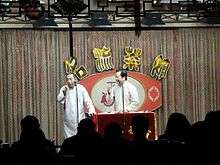
The city has many sights; its streetscapes – an assemblage of historic nineteenth - and early twentieth-century European architecture, juxtaposed with the concrete and glass monoliths of contemporary China – are its most engrossing attraction. Though wide swaths of the city are being redeveloped, much of the colonial architecture has been placed under protection, and the shopping opportunities, especially for antiques, just about justify a day-trip from the capital, an hour away by train.
In the nineteenth century, the port city caught the attention of the seafaring Western powers, who used the boarding of a British ship by Chinese troops as an excuse to declare war. With well-armed gunboats, they were assured of victory, and the Treaty of Tianjin, signed in 1856, gave the Europeans the right to establish nine concessionary bases on the mainland, from which they could conduct trade and sell opium. These concessions, along the banks of the Hai River, were self-contained European fantasy worlds: the French built elegant châteaux and towers, while the Germans constructed red-tiled Bavarian villas. Tensions between the indigenous population and the foreigners exploded in the Tianjin Incident of 1870, when a Chinese mob attacked a French-run orphanage, and again during the Boxer Rebellion in 1900, after which the foreigners levelled the walls around the old Chinese city to enable them to keep an eye on its residents.
The dense network of ex-concession streets south and west of the central train station, and south of the Hai River, now constitute the areas of most interest to visitors. Unmistakable are the châteaux of the French concession, which now make up the downtown district just south of the river, and the haughty mansions the British built east of here. Farther east, also south of the river, the architecture of an otherwise unremarkable district has a sprinkling of stern German constructions.
Landmarks and attractions
- Astor Hotel
- Binjiang Avenue shopping street
- Drum Tower
- Five Main Avenues
- Former Concessions in Tianjin
- Hai River Park
- Luzutang Boxer Rebellion Museum
- Memorial Hall to Zhou Enlai and Deng Yingchao
- Nanshi Cuisine Street
- People's Park
- St. Joseph's Cathedral of Tianjin
- Temple of Confucius Wen Miao
- Temple of Great Compassion
- Century Clock
- Tianjin Ancient Culture Street
- Tianjin Eye
- Tianjin Museum
- Tianjin Library
- Tianjin Art Gallery
- Tianjin Natural History Museum
- Tianjin Olympic Center Stadium, also known as "The Water Drop"
- Tianjin Radio and Television Tower
- Tianjin Water Park
- Tianjin World Financial Center
- Tianjin Zoo
- Yangliuqing (including Shi Family Grand Courtyard)
- Porcelain House
- Nankai University
- Nankai Middle School
- Tianjin University
Sights outside the old city urban core area, but within the municipality, including Binhai/TEDA:
- Huangya Pass, a section of the Great Wall of China
- Mount Panshan
- Sino-Singapore Tianjin Eco-city
- Soviet Aircraft Carrier Kiev
- Taku Forts
- TEDA Football Stadium, home stadium of Chinese Super League team Tianjin Teda F.C.
Culture
People from Tianjin speak the Tianjin dialect of Mandarin, from which it is derived. Despite its proximity to Beijing, the Tianjin dialect sounds quite different from the Beijing dialect, which provides the basis for Putonghua, the official spoken language of the People's Republic of China.
Tianjin is a respected home base of Beijing opera, one of the most prestigious forms of Chinese opera.
Tianjin is famous for its stand up comedy and comedians including Guo Degang and Ma Sanli. Ma Sanli (马三立) (1914–2003), an ethnic Hui and longtime resident of Tianjin, is renowned for his xiangsheng (相声), a hugely popular form of Chinese entertainment similar to comedy. Ma Sanli delivered some of his xiangsheng in the Tianjin dialect. Tianjin, along with Beijing, is a center for the art of xiangsheng. Tianjin's patented brand of stand-up also includes the use of rhythmic bamboo clappers "Kuaiban".[47]
Yangliuqing (Green Willows), a town about 15 km (9.3 mi) west of Tianjin's urban area and the seat of Xiqing District, is famous for its popular Chinese New Year-themed, traditional-style, colourful wash paintings (杨柳青年画). Tianjin is also famous for Zhang's clay figurines which are a type of colourful figurine depicting a variety of vivid characters, and Tianjin's Wei's kites, which can be folded to a fraction of their full sizes, are noted for portability.
On September 28, 2015, the Juilliard School in New York City announced a major expansion into Tianjin during a visit by China's first lady, Peng Liyuan, the institution's first such full-scale foray outside the United States, with plans to offer a master's degree program.[48]
Cuisine
Tianjin cuisine places a heavy focus on seafood, due to Tianjin's proximity to the sea. It can be further classified into several varieties, including the rough (Chinese: 粗; pinyin: cū), smooth (simplified Chinese: 细; traditional Chinese: 細; pinyin: xì), and high (Chinese: 高; pinyin: gāo). Prominent menus include the Eight Great Bowls (Chinese: 八大碗; pinyin: Bādà wǎn), a combination of eight mainly meat dishes, and the Four Great Stews (Chinese: 四大扒; pinyin: sì dà bā), actually referring to a very large number of stews, including chicken, duck, seafood, beef, and mutton.
The four delicacies of Tianjin include Goubuli baozi, Guifaxiang Shibajie Mahua (Chinese: 十八街麻花; pinyin: shíbā jiē máhuā), Erduoyan Zhagao (Chinese: 耳朵眼炸糕; pinyin: erduoyǎn zhà gāo) and Maobuwen Jiaozi (Chinese: 猫不闻饺子; pinyin: māo bù wén jiǎozi). Well-known foods include Caoji donkey meat, Bazhen sheep-leg mutton of Guanshengyuan, Luji Tangmian Zhagao, Baiji Shuijiao, Gaogan of Zhilanzhai, Guobacai of Dafulai, Kansubao of Shitoumen and Xiaobao chestnut. These famous snacks are available in Nanshi Food Street, which was a famous calling-card of Tianjin in the aspect of cuisine.
Transport

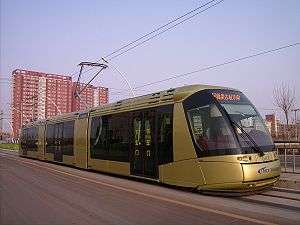 Translohr tram serving in Binhai New Area
Translohr tram serving in Binhai New Area Port of Tianjin pilot boat berth
Port of Tianjin pilot boat berth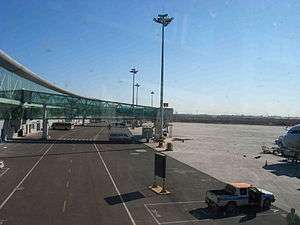 Tianjin Airport Terminal
Tianjin Airport Terminal
Port of Tianjin
Tianjin port is the world's top-level and China's largest artificial deep water harbor, and the throughput capacity ranks fifth in the world. Located in Binhai Economic Zone, a national new economic zone of China, Tianjin harbor is the port of call of international cruises visiting the wider area, including Beijing.
Trams
Tianjin's harbor area of Binhai/TEDA has an ultramodern, high speed rubber tired tram system, which is the first of its kind in China & Asia. Constructed in 2006, this marked a return of the tram to Tianjin, which once had an extensive standard steel-wheeled tramway network. The Tianjin tram network was constructed by a Belgian company in 1904 and opened in 1906. It was the first citywide tramway system in China. It closed in 1972.
Rapid transit
Light railway
There is also a light railway line in the city, the Binhai Mass Transit line. The line runs between downtown Tianjin and TEDA (Tianjin Economic Development Area) in the seaside region. The eastern part of the line began service on March 28, 2004. The western part of the line is scheduled to be completed in 2006.
There is also a guided rail tram system in TEDA, called TEDA Modern Guided Rail Tram.
Metro
The municipality consists of two rapid transit systems, Tianjin Metro and Binhai Mass Transit. They are currently under heavy expansion from five to nine lines. Five lines are currently operating both in the City and the Binhai area. As of October 2016, the entire network of Tianjin Metro and Binhai Mass Transit has 95 stations and 5 lines.
Construction work on the Tianjin Metro started on July 4, 1970. It was the second metro to be built in China and commenced service in 1984. The total length of track is 7.4 kilometres (5 miles). The metro service was suspended on October 9, 2001 for reconstruction. The original line is now part of Line 1 of the new metro system. It was re-opened to the public in June 2006. The track was extended to 26.188 km (16.272 mi) and there are a total of 22 stations. Construction work on Line 2 and Line 3 was completed in 2012 and the two lines are now in operation. Several new metro lines are planned.
There are two rapid transit operators in Tianjin:
- Tianjin Metro. Presently operating with 63 stations and four lines.
- Binhai Mass Transit (BMT). Currently operating 33 stations.
Current map of Tianjin Metro and Binhai Mass Transit

Rail
There are several railway stations in the city, Tianjin Railway Station being the principal one. It was built in 1888. The station was initially located at Wangdaozhuang (simplified Chinese: 旺道庄; traditional Chinese: 旺道莊; pinyin: Wàngdàozhuāng). The station was later moved to Laolongtou (simplified Chinese: 老龙头; traditional Chinese: 老龍頭; pinyin: Lǎolóngtóu) on the banks of the Hai He River in 1892, so the station was renamed Laolongtou Railway Station. The station was rebuilt from scratch in 1988. The rebuilding work began on April 15, 1987 and was finished on October 1, 1988. The Tianjin Railway Station is also locally called the 'East Station', due to its geographical position. In January 2007, the station began another long-term restructuring project to modernize the facility and as part of the larger Tianjin transport hub project involving Tianjin Metro lines 2, 3, and 9 as well as the Tianjin-Beijing High-speed rail.
Tianjin West Railway Station and Tianjin North Railway Station are also major railway stations in Tianjin. There is also Tanggu Railway Station is located in the important port area of Tanggu District, and Binhai Railway Station and Binhai North Railway Station located in TEDA, to the north of Tanggu. There are several other railway stations in the city that do not handle passenger traffic. Construction on a Beijing-Tianjin high-speed rail began on July 4, 2005 and was completed by August 2008.
The following rail lines go through Tianjin:
- Jingshan Railway, from Beijing to Shanhai Pass
- Jinpu Railway, from Tianjin to Pukou District, Nanjing
- Jinji Railway, from Tianjin urban area to Ji County, Tianjin
- Jinba Railway, from Tianjin to Bazhou, Hebei
The inter-city trains between Beijing and Tianjin will adopt a new numbering system: Cxxxx (C stands for interCity.). The train numbers range between C2001~C2298:
- C2001~C2198: From Beijing South Station to Tianjin, non-stop.
- C2201~C2268: From Beijing South Station to Tianjin, with stops at Wuqing Station (武清站);
- C2271~C2298: From Beijing South Station to Yujiapu Railway Station of Tianjin.[49]
The new C trains take only 30 min between Beijing and Tianjin, cutting the previous D train time by more than a half. The ticket price as of Aug. 15, 08 is 69 RMB for the first-class seat and 58 RMB for the second-class seat.
Bus
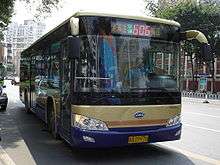
There were over 900 bus lines in the city as of 2005.[50]
Roads and expressways
Some roads and bridges have retained names that hark back to the Republic of China era (1912-1949) such as Minquan Gate and Beiyang Road. Like with most cities in China, many roads in Tianjin are named after Chinese provinces and cities. Also, Tianjin is unlike Beijing, in that very few roads run parallel to the major four cardinal directions.
Tianjin has three ring roads. The Inner and Middle Ring Roads are not closed, traffic-controlled roadways and some often have traffic light intersections. The Outer Ring Road is the closest thing to a highway-level ring road, although traffic is often chaotic.
Tianjin's roads often finish in dao (Chinese: 道; literally: "avenue"), xian (simplified Chinese: 线; traditional Chinese: 線; literally: "line"). These are most often used for highways and through routes. The terms lu (Chinese: 路; literally: "road"). Jie (Chinese: 街; literally: "street") are rare. As Tianjin's roads are rarely in a cardinal compass direction, jing (simplified Chinese: 经; traditional Chinese: 經; literally: "avenue") roads and wei (simplified Chinese: 纬; traditional Chinese: 緯; literally: "avenue") roads often appear, which attempt to run more directly north-south and east-west, respectively.
The following seven expressways of China run in or through Tianjin:
- Jingjintang Expressway, from Beijing, through Tianjin's urban area, to Tanggu District / TEDA
- Jinghu Expressway, from Jinjing Gonglu Bridge to Shanghai (together with Jingjintang Expressway, this is the expressway from Beijing to Shanghai)
- Jingshen Expressway, through Baodi District on its way from Beijing to Shenyang
- Tangjin Expressway, from Tanggu District, Tianjin, to Tangshan, Hebei—known in Tianjin as the Jintang Expressway
- Baojin Expressway, from Beichen District, Tianjin, to Baoding, Hebei—known in Tianjin as the Jinbao Expressway
- Jinbin Expressway, from Zhangguizhuang Bridge to Hujiayuan Bridge, both within Tianjin
- Jinji Expressway, from central Tianjin to Jixian County
The following six China National Highways pass through Tianjin:
- China National Highway 102, through Ji County, Tianjin on its way from Beijing to Harbin
- China National Highway 103, from Beijing, through Tianjin's urban area, to Tanggu District
- China National Highway 104, from Beijing, through Tianjin Municipality, to Fuzhou
- China National Highway 105, from Beijing, through Tianjin Municipality, to Macau
- China National Highway 112, circular highway around Beijing, passes through Tianjin Municipality
- China National Highway 205, from Shanhaiguan, Hebei, through Tianjin Municipality, to Guangzhou
Airport
Tianjin Binhai International Airport (ZBTJ) is located in Dongli District roughly 13 km (8 mi) away from downtown area. The city will also be served by the new Beijing Daxing International Airport in Beijing, currently under construction and to be completed by 2017.[51]
Tianjin Binhai International Airport now has a terminal building which covers an area of 25,000 m2 (269,000 sq ft), a merchandise warehouse which covers an area of 29,500 m2 (318,000 sq ft) and runways measuring 3.6 km (2.2 mi) in total. It has a grade 4E airstrip, which all kinds of large aircraft can take off from and land safely on. Tianjin Binhai International Airport[52] has 59 flight routes, connecting 48 cities, including 30 domestic cities and 17 foreign cities. Airline companies like Japan Airlines, All Nippon Airways, Korean Air, Asiana Airlines, Singapore Airlines Cargo and Martinair Holland all have flights to Tianjin Binhai International Airport.
Religion
Residents of Tianjin participate in indigenous religions, such as the veneration of the goddess Mazu. In addition, Tianjin has a Buddhist Temple of Great Compassion, a Catholic St. Joseph's Cathedral (Laoxikai Church), a Catholic Our Lady of Victory Church (Wanghailou Church). A Roman Catholic Diocese of Tianjin exists.[53] According to the Chinese General Social Survey of 2009, Christians constitute 1.51% of the city's population.[54] Tianjin has been described as a historically "strong center" of Islam in China.[55] Northwestern Tianjin is traditionally the location of the Muslim quarter of the city, where they have lived for centuries near the city's huge Great Mosque, Qingzhen si, founded in 1703.[56][57] Other mosques include the Dahuoxiang Mosque.[58]

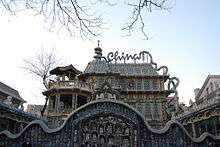
Sports
Sports teams based in Tianjin include: Chinese Super League
China Women Volleyball League
- Tianjin Bridgestone Women Volleyball Team
The 1995 World Table Tennis Championships were played in town.
Martial arts
Together with Beijing, Tianjin had been for many centuries considered a center for traditional Chinese martial arts. Many past and present masters of arts such as Bajiquan, Pigua Zhang, Xing Yi Quan, Bagua Zhang and others lived or are living in the city.[59][60][61] The districts most famous for martial arts in the city are Hong Qiao and Nankai, and martial artists abound in public green spaces such as Xigu Park and the Tianjin Water Park.
Education
Colleges and universities

Under the National Ministry of Education:
- Tianjin University (founded 1895, oldest university in China)
- Nankai University (founded 1919,one of the most prestigious universities in China)
Under the municipal government:
- Tianjin Polytechnic University
- Tianjin Medical University
- Tianjin Normal University
- Tianjin University of Science & Technology
- Tianjin University of Technology
- Tianjin University of Finance & Economics
- Tianjin University of Commerce
- Tianjin Academy of Fine Arts
- Tianjin Agricultural College
- Tianjin Conservatory of Music
- Tianjin Foreign Studies University
- Tianjin Institute of Physical Education
- Tianjin University of Technology and Education
- Tianjin University of Traditional Chinese Medicine
- Tianjin Urban Construction Institute
Under the national Civil Aviation Authority:
Under the government of Hebei Province:
- Hebei University of Technology (founded 1903, the earliest institute of technology in China)
Foreign institutions:
- The Florida International University Tianjin Center, opened in 2006 as a cooperative venture between the municipal government and the Miami-based university.
- The Great Wall MBA Program Oklahoma City University Meinders School of Business, established in 1986 on the campus of Tianjin University of Finance & Economics.[62]
- Raffles Design Institute Tianjin is a joint-project between Tianjin University of Commerce, Boustead College and Raffles Design Institute, Singapore.
Private:
Note: Institutions without full-time bachelor programs are not listed.
High schools
- Tianjin Nankai High School (天津市南开中学)was founded 1904, and one of the most prestigious in China
- Tianjin No.1 High School (天津市第一中学)[63]
- Tianjin Yaohua High School (天津市耀华中学) was founded 1927.
- Tianjin Xinhua High School (天津市新华中学)[64]
- Tianjin Exprimental High School (天津市实验中学)[65]
- Tianjin Tianjin High School(天津市天津中学)
- Tianjin Fuxing High School (天津市复兴中学)
- Tianjin Ruijing High School (天津市瑞景中学)
- The Foreign Languages School Affiliated to Tianjin Foreign Studies University (TFLS) (天津外国语学院附属外国语学校)[66]
- Tianjin No.20 High School (天津市第二十中学)
- Tianjin No.4 High School (天津市第四中学)[67]
- Tianjin Yangcun No.1 High School (天津市杨村第一中学)
- Tianjin Ji No.1 High School (天津市蓟县第一中学)
- Tianjin Dagang No.1 High School (天津市大港第一中学)
- Tianjin Second Nankai High School (天津市第二南开中学)[68]
- Tianjin Tanggu No.1 High School (天津市塘沽第一中学)
- Tianjin No.42 High School (天津市第四十二中学)
- Tianjin Baodi No.1 High School (天津市宝坻第一中学)
- Tianjin Dagang Oilfield Exprimental High School (天津市大港油田实验中学)
- Tianjin No.47 High School (天津市第四十七中学)[69]
- Tianjin No.7 High School (天津市第七中学)[70]
- Tianjin Jinghai No.1 High School (天津市静海第一中学)
- Tianjin Haihe High School (天津市海河中学)
- Tianjin Economic-Technological Development Area No. 1 High School (天津经济技术开发区第一中学)
- Tianjin No.55 High School (天津市第五十五中学)
- Tianjin High School Affiliated to Beijing Normal University (北京师范大学天津附属中学)
- Tianjin No.21 High School (天津市第二十一中学)
- Tianjin Xianshuigu No.1 High School (天津市咸水沽第一中学)
- The High School Affiliated to Nankai University(南开大学附属中学)
- Tianjin No.41 High School (天津市第四十一中学)
- Tianjin Lutai No.1 High School (天津市芦台第一中学)
- Tianjin No.2 High School (天津市第二中学)
- Tianjin No.3 High School (天津市第三中学)
- Tianjin Huiwen High School (天津市汇文中学)
- Tianjin Chonghua High School (天津市崇化中学)
- Tianjin No.100 High School (天津市第一〇〇中学)
- Tianjin Hangu No.1 High School(天津市汉沽第一中学)
- Tianjin Ziyun High School(天津市紫云中学)
- Tianjin No.102 High School (天津市第一〇二中学)
- Tianjin No.45 High School (天津市第四十五中学)
- Tianjin No.25 High School (天津市第二十五中学)
- The High School Affiliated to Tianjin University(天津大学附属中学)
- Tianjin No.5 High School (天津市第五中学)[71]
- Tianjin Yangliuqing No. 1 High School (天津市杨柳青第一中学)
- Tianjin No.14 High School (天津市第十四中学)
- Tianjin National High School (天津市民族中学)
- Tianjin No.54 High School (天津市第五十四中学)
- Tianjin No.43 High School (天津市第四十三中学)
- Tianjin Ironworks No.2 High School (天津铁厂第二中学)
- Tianjin No.9 High School (天津市第九中学)
- Tianjin No.57 High School (天津市第五十七中学)
- Tianjin No.51 High School (天津市第五十一中学)
- Tianjin Fulun High School (天津市扶轮中学)
- Tianjin Bohai Petroleum No.1 High School (天津市渤海石油第一中学)
Notable people from Tianjin
- Peng Shuai (1986–), is a Chinese professional female tennis player.
- Adeline Yen Mah (1937–), Chinese-born American author of Falling Leaves and Chinese Cinderella: The Secret Story of an Unwanted Daughter.
- Gao Lingwen (1862–1945), founder of Tianjin's first public school.
- Harry Kingman (1892–1982), the only major league baseball player born in China.
- Huo Yuanjia (1868–1910), famous Chinese martial artist and a co-founder of the Chin Woo Athletic Association.
- Wen Jiabao (1942–), former premier of China 2003–2013.
Twin Towns - Sister Cities
-
 Kobe, Japan
Kobe, Japan -
 Chiba, Japan[72]
Chiba, Japan[72] -
 Philadelphia, United States
Philadelphia, United States -
 Melbourne, Australia
Melbourne, Australia -
 Bangkok, Thailand
Bangkok, Thailand -
 Phnom Penh, Cambodia
Phnom Penh, Cambodia -
 Nampo, North Korea
Nampo, North Korea -
 Pyongyang, North Korea
Pyongyang, North Korea -
 Sarajevo, Bosnia and Herzegovina
Sarajevo, Bosnia and Herzegovina -
 Groningen, the Netherlands (since 1985)
Groningen, the Netherlands (since 1985) -
 Rishon Lezion, Israel
Rishon Lezion, Israel -
 İzmir, Turkey
İzmir, Turkey -
 Singapore, Singapore
Singapore, Singapore -
 Mar del Plata, Argentina (since 2001)
Mar del Plata, Argentina (since 2001) -
 Jönköping, Sweden (since 1993)[73]
Jönköping, Sweden (since 1993)[73]
See also
- Tianjin is also the name of an asterism in the Chinese constellation of Girl Mansion
- List of twin towns and sister cities in China
References
Notes
- ↑ 《2013中国人类发展报告》 (PDF) (in Chinese). United Nations Development Programme China. 2013. Retrieved 2014-01-05.
- ↑ "2015年天津市国民经济和社会发展统计公报-新闻中心-北方网". news.enorth.com.cn. Retrieved 2016-03-06.
- ↑ "最新中国城市人口数量排名(根据2010年第六次人口普查)". www.elivecity.cn. 2012. Retrieved 2014-05-28.
- ↑ "历史沿革". 天津政务网. 2009-12-04. Retrieved 2010-08-24.
- ↑ 天津河北人才被空吸 本地发展缓慢世界罕见,搜狐网,2010年8月20日
- ↑ Donati, Sabina, Italy's Informal Imperialism in Tianjin during the Liberal Epoch, 1902-1922, The Historical Journal, Cambridge University Press, 2016, available on CJO2016, doi:10.1017/S0018246X15000461.
- 1 2 3 4 5 6 John King Fairbank (1978). The Cambridge History of China. Cambridge University Press. ISBN 978-0-521-22029-3.:266–267
- ↑ Michael Lackner, Ph.D.; Natascha Vittinghoff (January 2004). Mapping Meanings: The Field of New Learning in Late Qing China ; [International Conference "Translating Western Knowledge Into Late Imperial China", 1999, Göttingen University]. BRILL. pp. 269–. ISBN 90-04-13919-2.
- ↑ "World Economic Forum: The Inaugural Annual Meeting of the New Champions". China.org. Retrieved 29 August 2008.
- ↑ the CNN Wire Staff (October 4, 2010). "Global climate talks kick off in China". CNN. Retrieved 2011-03-15.
- ↑ "China blasts: Casualties as Tianjin warehouse blows up". BBC News.
- ↑ Graham-Harrison, Emma (12 August 2015). "Explosions in Chinese city of Tianjin kill at least 17 and injure hundreds". The Guardian. Retrieved 12 August 2015.
- ↑ "Huge explosions in China's Tianjin port area kill 17, hurt 400". Yahoo! News. 13 August 2015. Retrieved 13 August 2015.
- ↑ "Tianjin explosion: China sets final death toll at 173, ending search for survivors". the Guardian. Associated Press. Retrieved 14 September 2015.
- ↑ "155位"8–12"事故遇难者身份公开" (in Chinese). Sohu. 2 September 2015. Archived from the original on 14 September 2015. Retrieved 2 September 2015.
- ↑ 天津地理位置、行政区划、人口民族概况 (in Chinese). Chinagate. 30 November 2007. Retrieved 2012-07-17.
- ↑ Peel, M. C. and Finlayson, B. L. and McMahon, T. A. (2007). "Updated world map of the Köppen-Geiger climate classification". Hydrol. Earth Syst. Sci. 11: 1633–1644.
- ↑ "Extreme Temperatures Around the World". Retrieved 2010-08-28.
- ↑ 中国气象局 国家气象信息中心 (in Chinese). China Meteorological Administration. June 2011. Archived from the original on July 10, 2014. Retrieved 2010-11-20.
- ↑ "China's Tianjin to restrict vehicle use to curb pollution". Retrieved 2010-10-14.
- ↑ "Paartalu Airs Player Concerns about Smoggy China". Retrieved 2010-10-14.
- ↑ 国家统计局统计用区划代码
- ↑ 《保定经济统计年鉴2011》
- ↑ shi, Guo wu yuan ren kou pu cha ban gong; council, Guo jia tong ji ju ren kou he jiu ye tong ji si bian = Tabulation on the 2010 population census of the people's republic of China by township / compiled by Population census office under the state; population, Department of; statistics, employment statistics national bureau of (2012). Zhongguo 2010 nian ren kou pu cha fen xiang, zhen, jie dao zi liao (Di 1 ban. ed.). Beijing Shi: Zhongguo tong ji chu ban she. ISBN 978-7-5037-6660-2.
- ↑ 《中国民政统计年鉴2012》
- ↑ "Statistical Communiqué of the People's Republic of China on the 2013 National Economic and Social Development". National Bureau of Statistics of China. 24 February 2014.
- ↑ "Tianjin Airport International Logistics Zone". RightSite.asia. Retrieved 2011-03-15.
- ↑ "Tianjin Export Processing Zone". RightSite.asia. Retrieved 2011-03-15.
- ↑ "Tianjin Port Free Trade Zone | China Industrial Space". Rightsite.asia. Retrieved 2012-12-11.
- ↑ "Tianjin Tanggu National Marine High-Tech Development Area | China Industrial Space". Rightsite.asia. Retrieved 2012-12-11.
- ↑ "第二次湖南R&D资源清查主要数据公报(第四号)". Stats.gov.cn. 2011-02-21. Archived from the original on 2011-09-27. Retrieved 2011-03-15.
- ↑ "天津市年末总人口控制在1535万人以下-新闻中心-北方网". enorth.com.cn.
- ↑ Source: Department of Population, Social, Science and Technology Statistics of the National Bureau of Statistics of China (國家統計局人口和社會科技統計司) and Department of Economic Development of the State Ethnic Affairs Commission of China (國家民族事務委員會經濟發展司), eds. Tabulation on Nationalities of 2000 Population Census of China (《2000年人口普查中國民族人口資料》). 2 vols. Beijing: Nationalities Publishing House (民族出版社), 2003. (ISBN )
- ↑ 天津人民广播电台 (in Chinese). Radiotj.com. 2010-12-22. Retrieved 2011-03-15.
- ↑ (Chinese)
- ↑ (Chinese)
- ↑ "Jin". Jinmagazine.com.cn. 2011-08-16. Archived from the original on July 16, 2012. Retrieved 2012-12-11.
- ↑ Tianjin Plus. "Tianjin Plus". Tianjinplus.com. Retrieved 2012-12-11.
- ↑ "Business Tianjin". Businesstianjin.com. Archived from the original on June 8, 2012. Retrieved 2012-12-11.
- ↑ Walravens, p. 90.
- 1 2 United States Bureau of Foreign and Domestic Commerce, p. 187.
- ↑ United States Bureau of Foreign and Domestic Commerce, p. 188.
- ↑ Hille, Kathrin (November 4, 2012). "China's 'Manhattan' becomes censorship capital". Financial Times. Retrieved 29 January 2016.
- ↑ Walravens, p. 91.
- ↑ Hille, Kathrin (November 4, 2012). "China's 'Manhattan' becomes censorship capital". Financial Times. Retrieved 29 January 2016.
- ↑ "At Sina Weibo's censorship hub, China's Little Brothers cleanse online chatter". Reuters. 11 September 2013. Retrieved 29 January 2016.
- ↑ McDougall, Bonnie S. (1984). Popular Chinese literature and performing arts in the People's Republic of China, 1949–1979. University of California Press. p. 84.
- ↑ Michael Cooper (September 28, 2015). "Juilliard's China Plans Move Forward". The New York Times. Retrieved February 3, 2016.
- ↑ "New Beijing-Tianjin intercity train numbering system". Shike.org.cn. 2008-07-31. Retrieved 2011-03-15.
- ↑ Tianjin Bus Company official website. (Chinese)
- ↑ Moore, Malcolm (September 9, 2011). "China to build world's biggest airport". The Daily Telegraph. London.
- ↑ "Tianjin Binhai Airport - Map, Airport China, China Airport, Tianjing Binhai International Airport". Airport-china.com. 1950-05-01. Archived from the original on December 9, 2013. Retrieved 2012-12-11.
- ↑ "Refugee Review Tribunal Australia - RRT Research Response". 2007-04-16. Retrieved 2014-01-08.
- ↑ China General Social Survey (CGSS) 2009. Report by: Xiuhua Wang (2015, p. 15)
- ↑ Raphael Israeli (2002). Islam in China: Religion, Ethnicity, Culture, and Politics. Lexington Books. p. 105. ISBN 9780739103753.
- ↑ Ruth Rogaski (2004). Hygienic Modernity: Meanings of Health and Disease in Treaty-Port China. University of California Press. pp. 56, 171, 245. ISBN 9780520930605.
- ↑ Bloom, Jonathan; Blair, Sheila S., eds. (2009). The Grove Encyclopedia of Islamic Art and Architecture. Oxford University Press. p. 484. ISBN 9780195309911.
- ↑ Steinhardt, Nancy Shatzman, ed. (2002). Chinese Architecture (illustrated ed.). Yale University Press. p. 36. ISBN 9780300095593.
- ↑ "Cook Ding's Kitchen: The World of Martial Arts That Has Long Since Passed". cookdingskitchen.blogspot.co.il.
- ↑ "Cook Ding's Kitchen: Master Zhou: The Man, The Artist, The Teacher". cookdingskitchen.blogspot.co.il.
- ↑ "The Martial Spirit of Tianjin – An Interview with Nitzan Oren By Jonathan Bluestein. - Masters of the IMA". Masters of the IMA.
- ↑ "Great Wall MBA Program". Okcu.edu. Archived from the original on 2010-06-10. Retrieved 2012-12-11.
- ↑ "Tianjin No. 1 High School". Tjyz.org. Retrieved 2012-12-11.
- ↑ "Tianjin Xinhua High School". Xinhuaedu.cn. Retrieved 2012-12-11.
- ↑ Tianjin Shiyan High School Archived August 15, 2015, at the Wayback Machine.
- ↑ "Tianjin Foreign Languages School (TFLS)". Tjfls.cn. Archived from the original on January 15, 2013. Retrieved 2012-12-11.
- ↑ "Tianjin No. 4 High School". Tj4z.cn. 2012-03-28. Retrieved 2012-12-11.
- ↑ "Tianjin Second Nankai High School". Tj.xinhuanet.com. Retrieved 2012-12-11.
- ↑ "Tianjin No. 47 High School". Tj47zx.org.
- ↑ "Tianjin No. 7 High School". Tjqz.org. Retrieved 2012-12-11.
- ↑ "Tianjin No. 5 High School". Tj5ms.cn. Retrieved 2012-12-11.
- ↑ "International Exchange". List of Affiliation Partners within Prefectures. Council of Local Authorities for International Relations (CLAIR). Retrieved 21 November 2015.
- ↑ "jonkoping.se".
Bibliography
- Miscellaneous series, Issues 7-11. United States Department of Commerce, Bureau of Foreign and Domestic Commerce, 1912.
- Walravens, Hartmut. "German Influence on the Press in China." - In: Newspapers in International Librarianship: Papers Presented by the Newspaper Section at IFLA General Conferences. Walter de Gruyter, January 1, 2003. ISBN 3110962799, 9783110962796.
- Also available at (Archive) the website of the Queens Library - This version does not include the footnotes visible in the Walter de Gruyter version
- Also available in Walravens, Hartmut and Edmund King. Newspapers in international librarianship: papers presented by the newspapers section at IFLA General Conferences. K.G. Saur, 2003. ISBN 3598218370, 9783598218378.
Further reading
- O. D. Rasmussen (1925). Tientsin: An Illustrated Outline History. University of Michigan: Tientsin Press. OCLC 2594229.
- Sabina Donati, Italy's Informal Imperialism in Tianjin during the Liberal Epoch, 1902-1922, The Historical Journal, Cambridge University Press, 2016, available on CJO2016, doi:10.1017/S0018246X15000461.
- Maurizio Marinelli, Giovanni Andornino, Italy's Encounter with Modern China: Imperial dreams, strategic ambitions, New York: Palgrave Macmillan, 2014.
- Maurizio Marinelli, "The Triumph of the Uncanny: Italians and Italian Architecture in Tianjin", In Cultural Studies Review, Vol. 19, 2, 2013, 70-98.
- Maurizio Marinelli, "The Genesis of the Italian Concession in Tianjin: A Combination of Wishful Thinking and Realpolitik". Journal of Modern Italian Studies, 15 (4), 2010: 536-556.
External links
| Wikimedia Commons has media related to: |
| Wikivoyage has a travel guide for Tianjin. |
- Tianjin Government website
- Economic profile for Tianjin at HKTDC
- Official Tianjin Media Gateway
- Historic US Army map of Tianjin, 1945
- Official promotional video of Tianjin City
-
 Chisholm, Hugh, ed. (1911). "Tientsin". Encyclopædia Britannica (11th ed.). Cambridge University Press.
Chisholm, Hugh, ed. (1911). "Tientsin". Encyclopædia Britannica (11th ed.). Cambridge University Press.
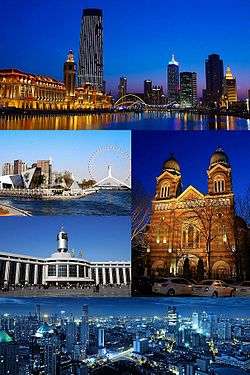
.svg.png)
.svg.png)
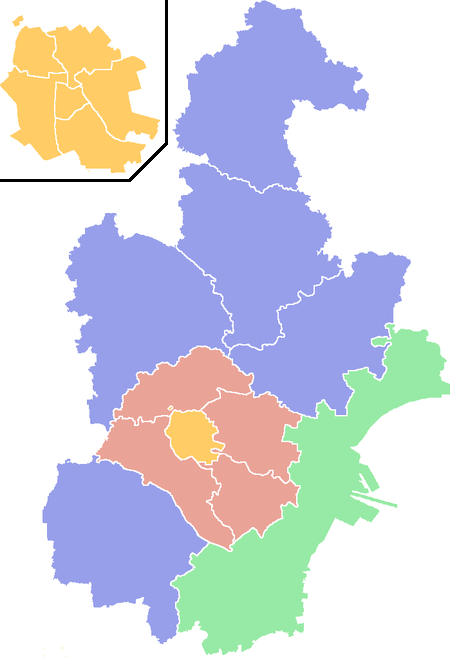

.jpg)
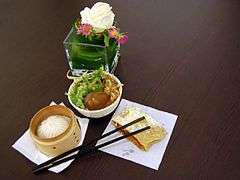

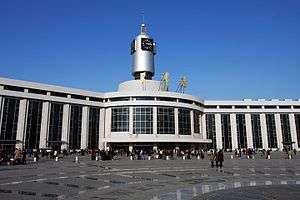
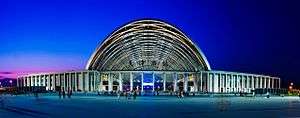
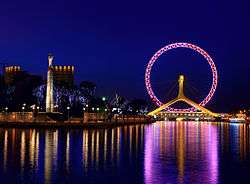
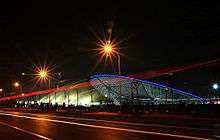

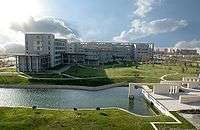



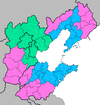
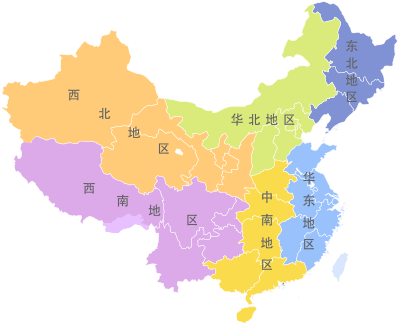

.jpg)
